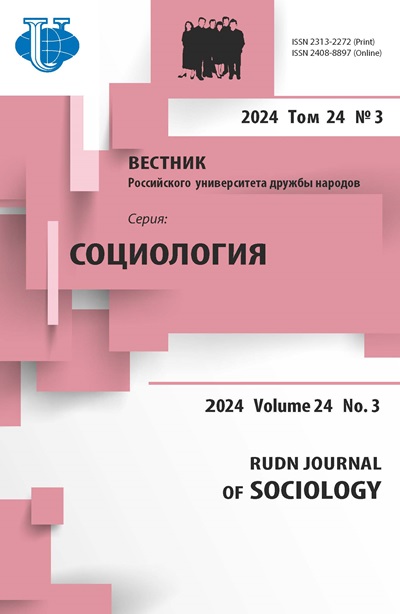Агентность и воспроизводство социальных структур: на примере вахтового труда в Республике Башкортостан
- Авторы: Туракаев М.С.1
-
Учреждения:
- Санкт-Петербургский государственный университет
- Выпуск: Том 16, № 3 (2016)
- Страницы: 599-610
- Раздел: Массовые опросы, эксперименты, кейс-стади
- URL: https://journals.rudn.ru/sociology/article/view/14005
Цитировать
Полный текст
Аннотация
В статье рассмотрены образ, стиль жизни и место на рынке труда (трудовые позиции) вахтовых рабочих из сельских районов Республики Башкортостан. Данная социальная группа является достаточно многочисленной и специфичной для Приволжского федерального округа России. Ее отличительными чертами служат мобильная занятость, регулярность маятниковых перемещений и т.д. Ключевая проблема исследования заключается в анализе агентности и воспроизводства социальных структур в сфере вахтового труда, места и роли вахтовых работников в социальном пространстве российского региона. Сообщество вахтовых работников предстает как социальное пространство позиций (внешних социальных структур в сфере трудовой занятости), социальное поле их образа жизни и индивидуальных характеристик (стиля жизни, культурного капитала и габитуса). Взаимодействие социального пространства вахтовых позиций, образа и стиля жизни индивидов основано на принципе «дуальности» структуры, который противостоит и противоречит принципу «дуализма» структуры. Различия обоих принципов рассмотрены в контексте теории структурации, конструктивистского структурализма и критического реализма. Методологически анализ трудового участия и жизнедеятельности вахтовых работников осуществляется на базе концепции дуальности структуры. Трудовая карьера и сельский образ жизни вахтовых рабочих детерминируются институциональными условиями, которые ограничивают их поведение в процессе воспроизводства социальных структур. Стиль жизни вахтовых работников определяется относительно свободным выбором ими досуга и свободного времени в период пребывания в домашней сельской обстановке и характеризует их агентность. Избирательность их досуговых практик отражается в устоявшемся стиле жизни, зависящем от ограничений социального поля сельского образа жизни и образа жизни на работе (вахте). Воспроизводство иерархии трудовых позиций вахтовых работников в социальном пространстве обеспечивается переплетением элементов стиля жизни (в частности, культурный капитал, привычки) и образа жизни (например, благосостояние).
Об авторах
Марсель Салаватович Туракаев
Санкт-Петербургский государственный университет
Автор, ответственный за переписку.
Email: mturakaev@gmail.com
Санкт-Петербург, Россия
Список литературы
- Бурдье П. Физическое и социальное пространства // Бурдье П. Социология социального пространства. М.-СПб.: Институт экспериментальной социологии; Алетейя, 2007.
- Гидденс Э. Устроение общества. Очерк теории структурации. М.: Академический проект, 2005.
- Ильин В.И. Феномен поля: от метафоры к научной категории // Рубеж (альманах социальных исследований). 2003. № 18.
- Плюснин Ю.М., Заусаева Я.Д., Жидкевич Н.Н., Позаненко А.А. Отходники. М.: Новый Хронограф, 2013.
- Стадник А.Т., Шаравина Е.В. Вахтовый метод организации сельскохозяйственного производства // Вестник Новосибирского государственного аграрного университета. 2011. Т. 4. № 20.
- Штомпка П. Социология социальных изменений. М.: Аспект-Пресс, 1996.
- Archer M. Realist Social Theory: The Morphogenetic Approach. Cambridge: Cambridge University Press, 1995.
- Bourdieu P., Wacquant L. An Invitation to Reflexive Sociology. Chicago: University of Chicago Press, 1992.
- Elder-Vass D. The Causal Power of Social Structures: Emergence, Structure and Agency. Cambridge: Cambridge University Press, 2011.
- Giddens A. A Contemporary Critique of Historical Materialism. Vol. 1. Power, property and the state. Berkley; Los Angeles: University of California Press, 1981.
- Giddens A., Pierson C. Conversations with Anthony Giddens: Making Sense of Modernity. L.: Polity Press, 1998.
- Kemp S. Interests and structure in dualist social theory: a critical appraisal of Archer's theoretical and empirical arguments // Philosophy of the Social Sciences. 2012. No 42.
- Porpora D.V. Morphogenesis and Social Change. Social Morphogenesis / Ed. by M. Archer. L., 2013.
- Stones R. Refusing the realism - structuration divide // European journal of Social Theory. 2001. Vol. 4. No 2.
- Wright E.O. Class Counts: Comparative Studies in Class Analysis. Cambridge: Cambridge University Press, 2000.














